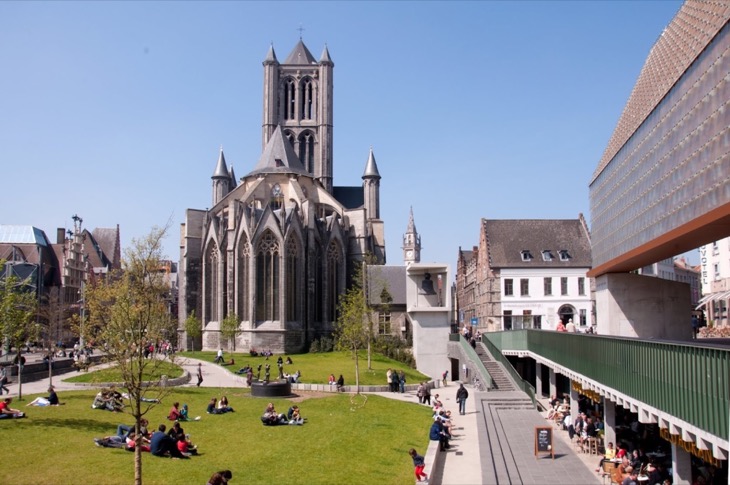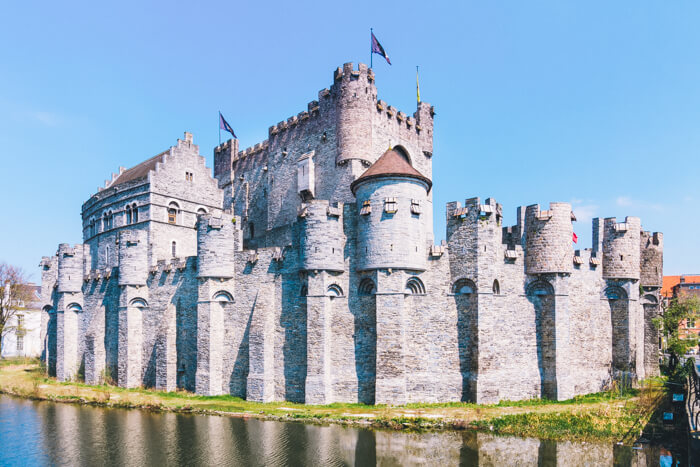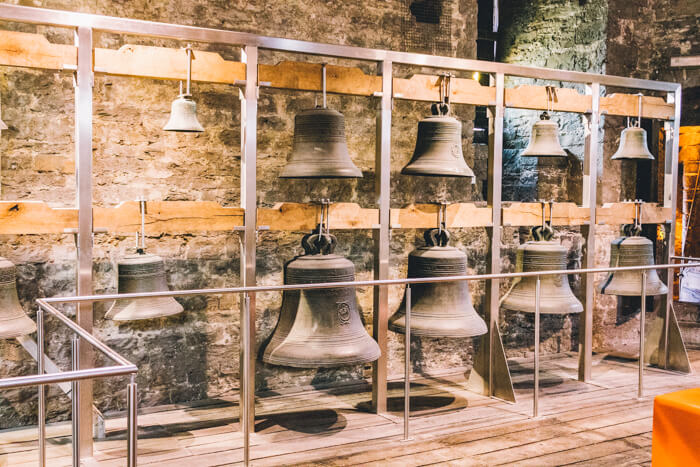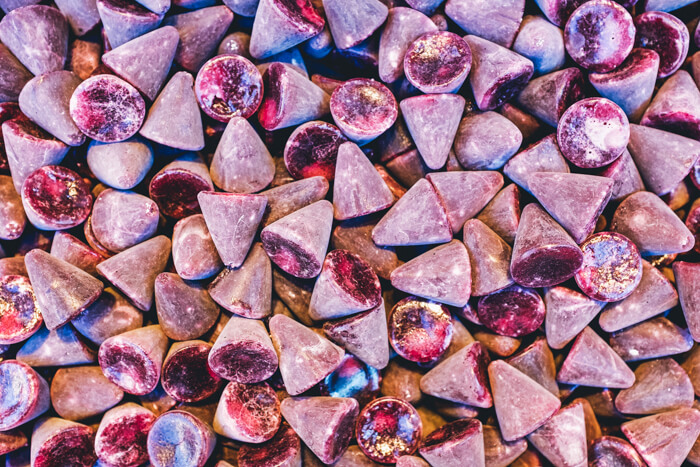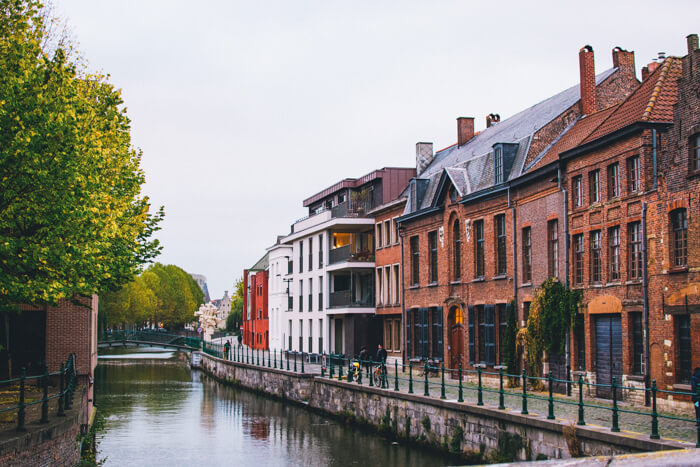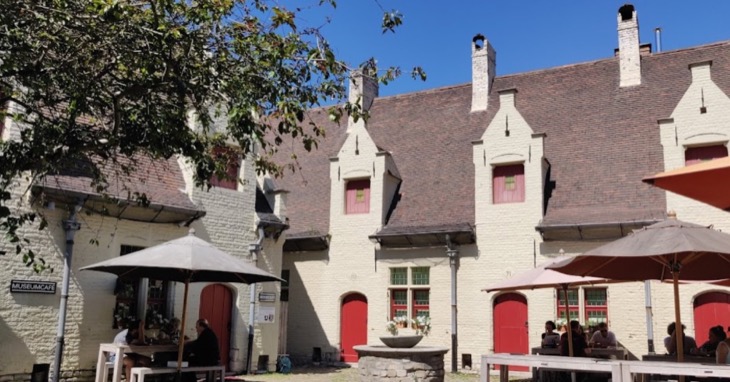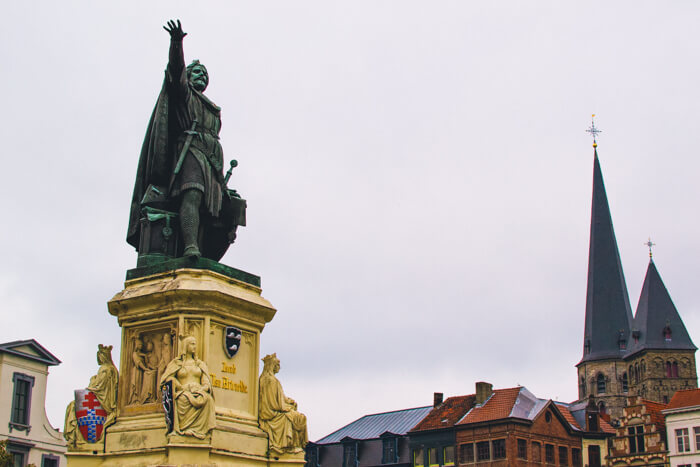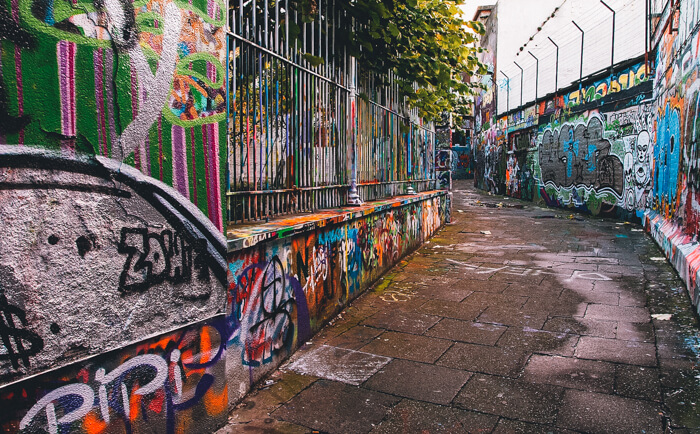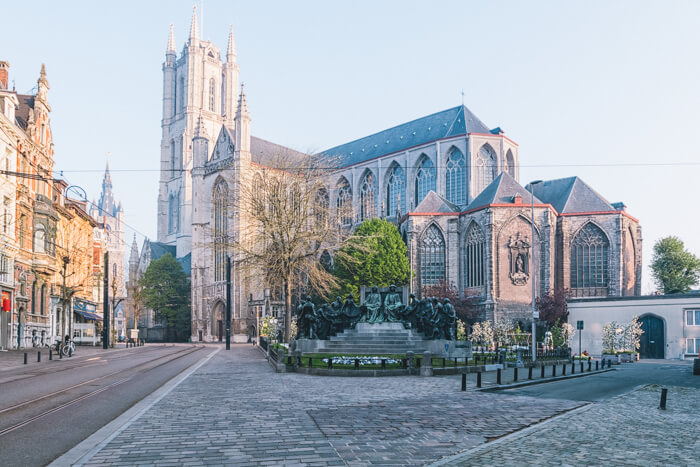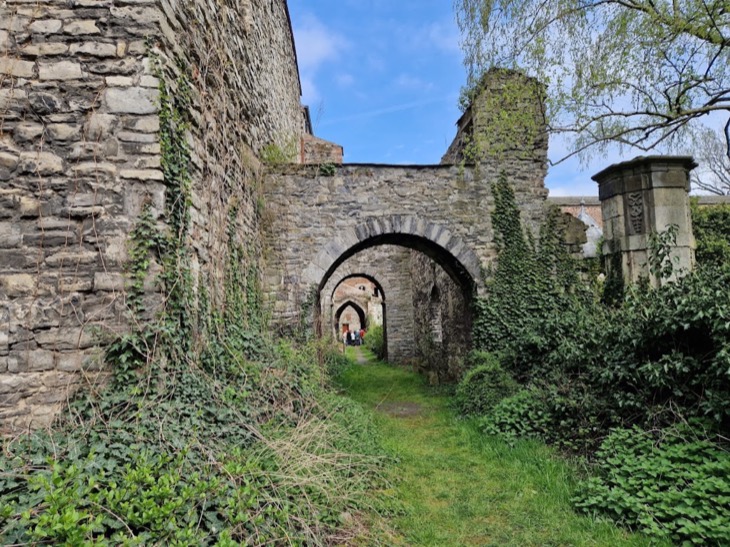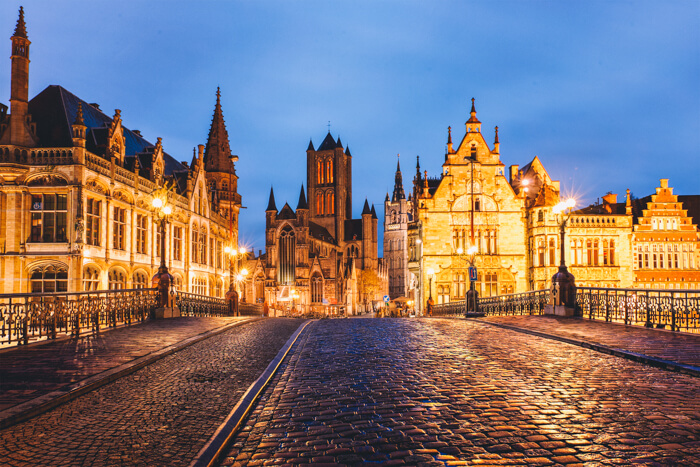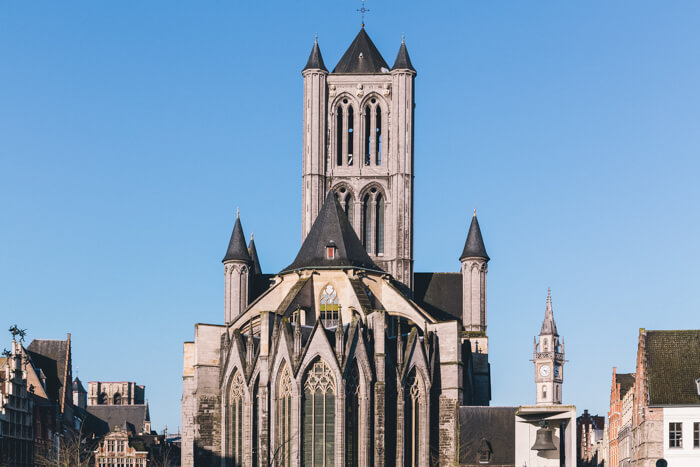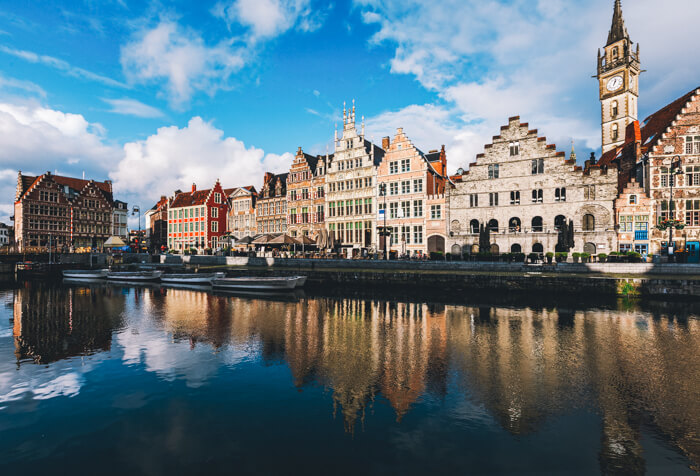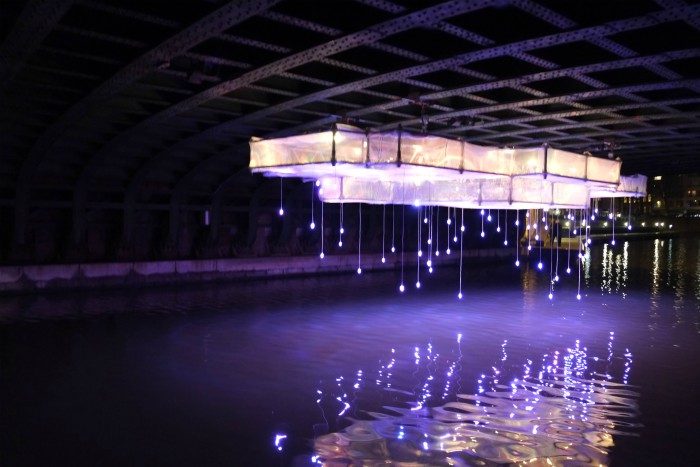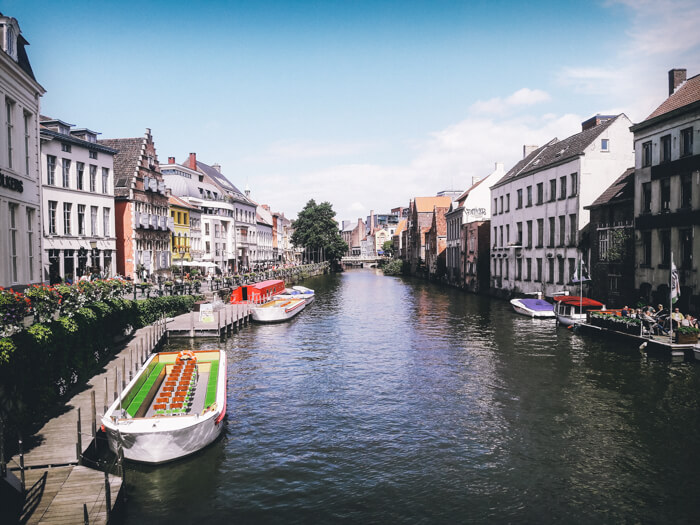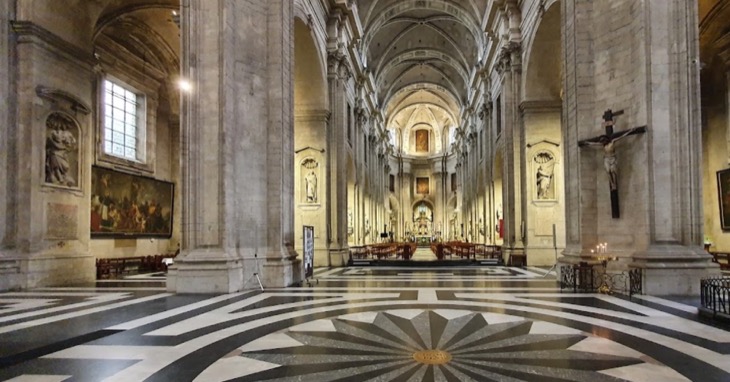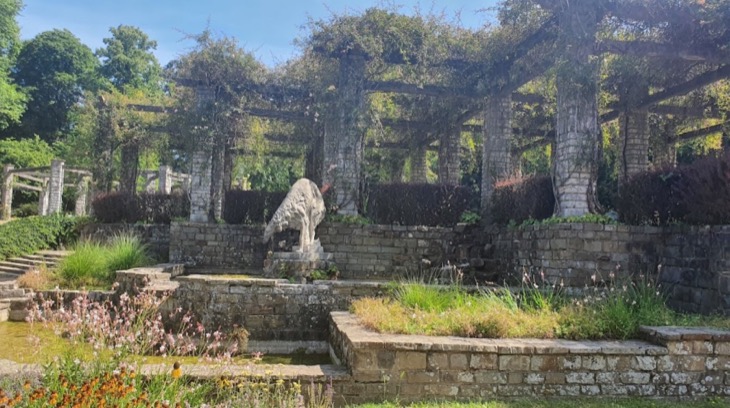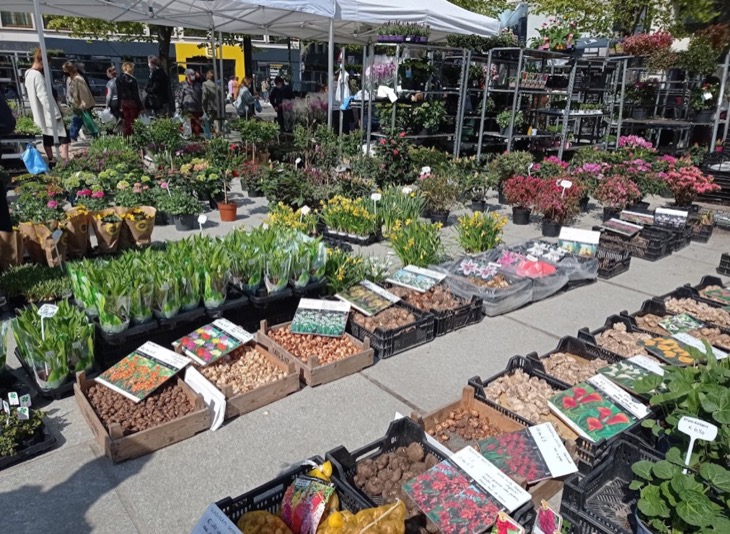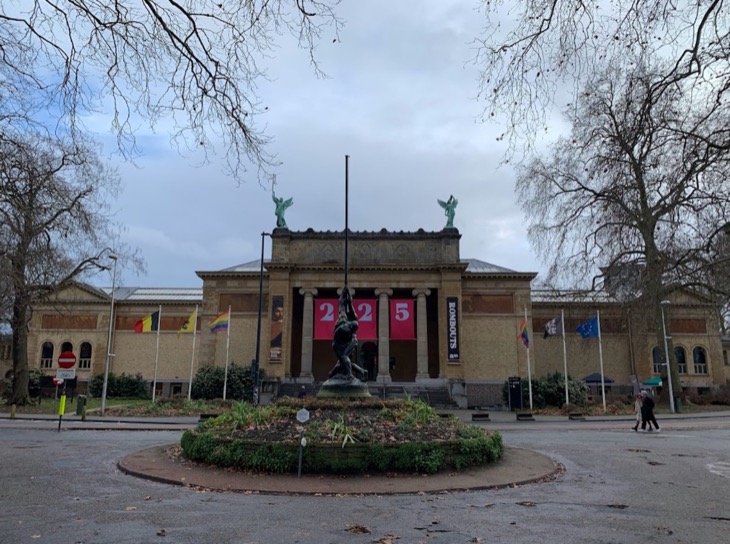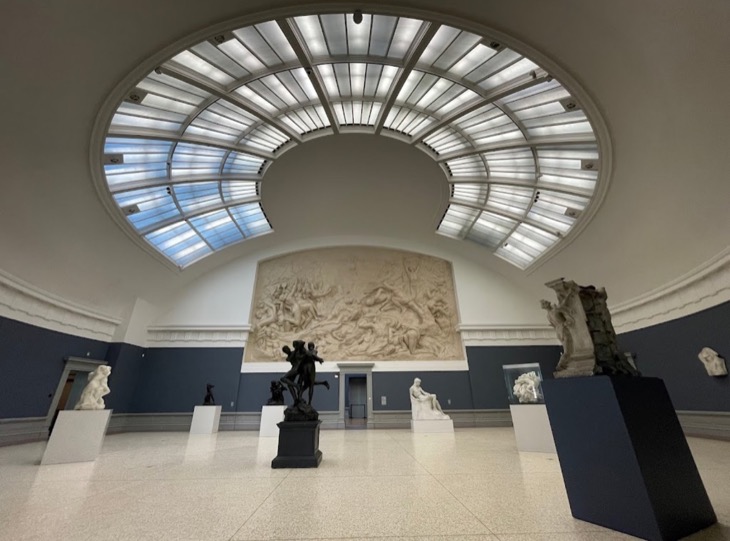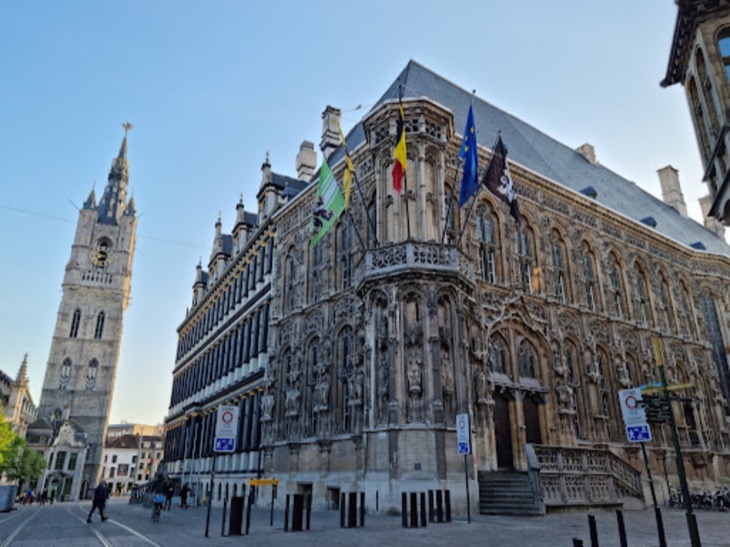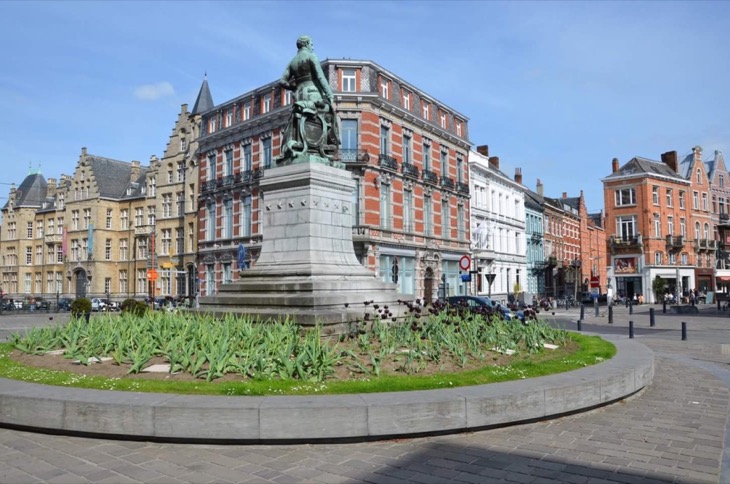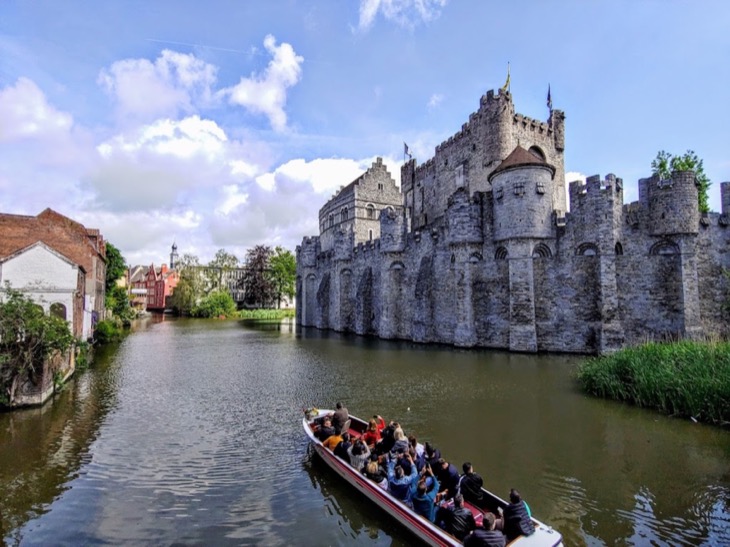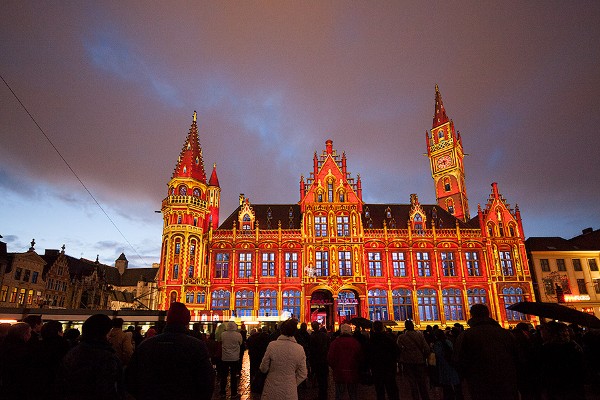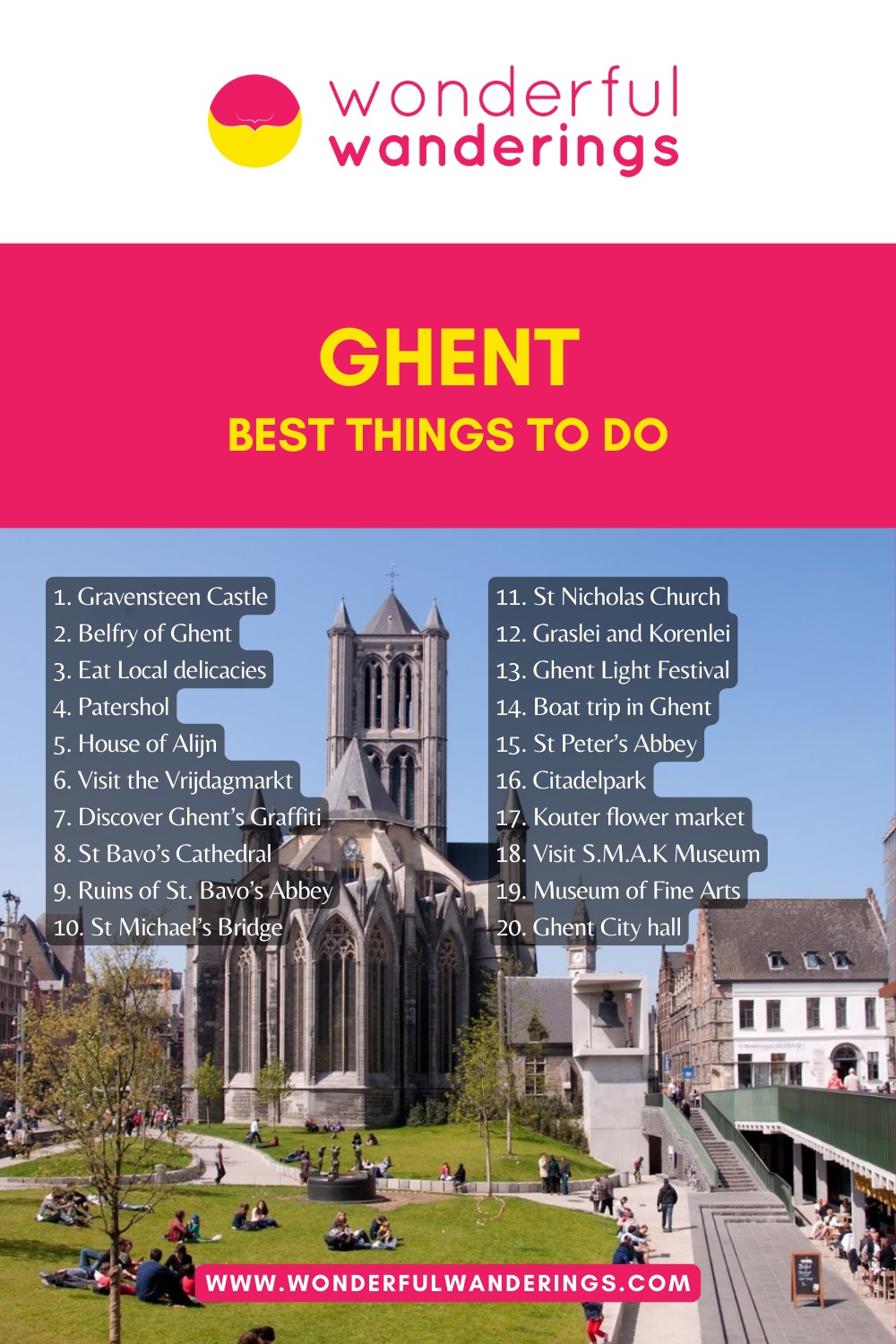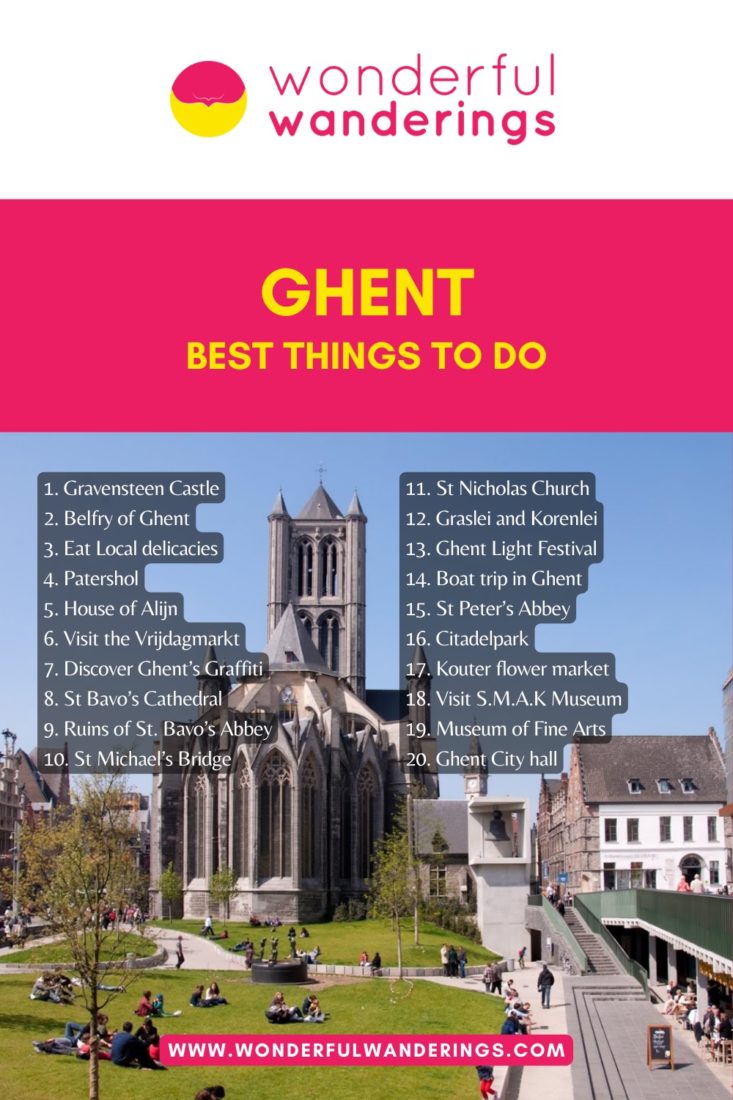Ghent is a historic city located in the Flanders region of Belgium. Ghent’s origin dates back to the 10th century, but then grew to become one of the largest and richest cities in northern Europe by the 13th century due to its thriving cloth trade industry. However, the city went through an economic decline in the 16th century. Today, Ghent has transitioned into a modern city and is considered one of Belgium’s best-kept secrets.
Ghent’s well-preserved mediaeval architecture makes it a popular tourist destination. The city center is car-free, and landmarks like the 14th-century Belfry tower and 12th-century St. Bavo’s Cathedral draws many visitors daily. Inside St. Bavo’s Cathedral lies one of Ghent’s most prized treasures – the 15th-century Ghent Altarpiece, an intricate polyptych altarpiece featuring paintings by Jan van Eyck. Ghent is also home to Gravensteen Castle, which was built in 1180 and houses a museum today.
When visiting Ghent, climbing the belfry’s 366 steps rewards visitors with panoramic views of the city and its many church spires. At night, Ghent’s architecture and riverfront are illuminated, giving the city a magical charm. The city celebrates with the lively, 10-day Ghent Festivities each July. Foodies will enjoy the region’s specialty dishes like waterzooi stew, as well as praline chocolates and cone-shaped cuberdons candies.
Listed below are the best things to do in Ghent.
- Tour Gravensteen Castle. Gravensteen Castle is a medieval castle in central Ghent, Belgium. Originally built in 1180, it has many original features like imposing stone walls, towers, central keep and moat. Visitors can explore dungeons, see torture devices and medieval artifacts. Located at Sint-Veerleplein 11, the castle appeals to history and architecture lovers. Admission is 13 € ($14, £11). Open daily 10am-6pm.
- Climb the Belfry of Ghent. The Belfry of Ghent is a 13th century bell tower in Ghent’s historic center. At 91 meters tall, it offers panoramic city views. Its spire has a golden dragon weathervane from 1377. The tower contains a carillon with 54 bells and is part of a UNESCO World Heritage site. Visitors can take the lift or climb 366 steps to the top. Located off Sint-Baafsplein, the belfry appeals to sightseers and photographers. Admission is 11€ ($12, £10). Open daily 10am-6pm.
- Eat local culinary delicacies in Ghent. Ghent has signature local delicacies like the purple conical raspberry-flavored candy called cuberdon and the vegetable stew Gentse waterzooi. The Great Butchers’ Hall displays over 175 regional products. Ghent is a haven for vegetarians with “veggie days” on Thursdays in restaurants. Foodies flock here for the diverse cuisine.
- Stroll through the streets in Patershol. Patershol is a historic neighborhood with cobblestone streets and medieval architecture dating to the 12th century. Once home to leather traders, it is now a trendy district with restaurants, bars, galleries and cafés. Located by the Castle of the Counts, it offers charming ambience. Patershol appeals to photographers and foodies.
- Discover the House of Alijn. The House of Alijn in a former children’s hospital illuminates daily life in 20th century Ghent through recreated shops, exhibits and artifacts. Located at Kraanlei 65, it appeals to all ages. Hands-on exhibits bring history to life. Admission is 9€ ($9.50, £7.70). Open Tuesday-Sunday 10am-5pm, closed Mondays.
Contents
- 1. Tour Gravensteen Castle
- 2. Climb the Belfry of Ghent
- 3. Eat local culinary delicacies in Ghent
- 4. Stroll through the streets in Patershol
- 5. Discover the House of Alijn
- 6. Explore the Friday market in Vrijdagmarkt
- 7. Discover Ghent’s Graffiti
- 8. Marvel inside St Bavo’s Cathedral
- 9. Wander through the ruins of medieval St. Bavo’s Abbey
- 10. Enjoy romantic views from St Michael’s Bridge
- 11. Appreciate the Gothic architecture at St Nicholas Church
- 12. Relax at a canal-side cafe on Graslei and Korenlei
- 13. Experience magical light installations at the Ghent Light Festival
- 14. Cruise along on a boat trip on Ghent’s medieval waterways
- 15. Find peace in St Peter’s Abbey’s secluded gardens
- 16. Stroll through Citadelpark
- 17. Shop for flowers at the Kouter flower market
- 18. Discover the contemporary art at S.M.A.K Museum
- 19. View masterpieces at the Museum of Fine Arts
- 20. Tour the Ghent City hall
1. Tour Gravensteen Castle
Gravensteen Castle is a medieval castle located in the heart of Ghent, Belgium. Gravensteen Castle, also know as “Castle of the Counts”, was originally built in 1180 by Philip of Alsace, who was inspired by the crusader castles he saw during the Second Crusade. Gravensteen Castle served as the residence of the Counts of Flanders until 1353, when it was converted into a courthouse and prison. Gravensteen Castle is one of the best-preserved medieval castles in Belgium and Europe. The castle has many original features intact, including the imposing stone walls and towers, the central keep and the moat. Visitors can explore dungeons, view torture devices and see exhibits of medieval weapons and armor.
Gravensteen Castle is located in the old town of Ghent, at the address Sint-Veerleplein 11, 9000 Ghent, Belgium. Ghent is situated in the Flanders region of Belgium, around 30 miles (50 km) northwest of Brussels. The nearest train station is Gent-Sint-Pieters Station, which has regular trains from Brussels and other major Belgian cities. From the train station, tram lines 1 and 4 stop at the Gravensteen tram stop, just a short walk from the castle entrance. Alternatively, the castle can be reached by car, with parking available at nearby garages.
Gravensteen Castle is suitable for visitors of all ages, especially those interested in medieval history and architecture. Families with kids will enjoy exploring the castle’s towers and dungeons. Admission costs 13 € ($14, £11) for adults, with discounted rates for seniors and students aged 19-25 and free entry for children under 19. The castle is open daily, with hours from 10am to 6pm with last admission at 4:40pm . Guided tours are available to enhance the experience and audio guides are included with admission. Visiting Gravensteen Castle offers the opportunity to immerse yourself in medieval Ghent and Belgium’s history.
2. Climb the Belfry of Ghent
The Belfry of Ghent is a medieval bell tower located in the historic center of Ghent, Belgium. It stands 91 meters (299 feet) tall and is one of the Three Towers of Ghent, along with the Saint Bavo Cathedral and Saint Nicholas Church towers. The address of the Belfry of Ghent is Sint-Baafsplein, 9000 Gent, Belgium.
The Belfry of Ghent was built between 1313 and 1380 and served as the city’s watchtower, treasury and archive. It was part of the set of Belfries in Belgium and France that were named a UNESCO World Heritage Site in 1999. The tower is renowned for its Brabantian Gothic architecture featuring a stone spire designed by architect Jan van Haelst.
A notable feature of the Belfry is the golden dragon weathervane that tops its spire. This statue was made in Bruges in 1377 and installed on the tower around 1380. The dragon is a symbolic guardian of the city that has watched over Ghent for centuries. Inside, the tower contains a carillon with 54 bells that regularly chime. Visitors can take a lift or climb the 366 steps to reach the top floor belfry and take in panoramic views over Ghent.
To reach the Belfry of Ghent, travelers can take public transit to the Gent Korenmarkt stop. This stop is served by tram lines 1 and 4 as well as bus N4. The tower is just a short walk from the tram and bus stop. Alternatively, the tower can be reached by car or on foot from most places in the compact city center of Ghent.
The Belfry of Ghent is an ideal activity for adults and older children interested in architecture, history and panoramic views. There is an admission fee of 11€ ($12, £10) for adults, with discounted rates available for seniors, students, children and visitors with disabilities. Children under 12 years can enter for free. The tower is open daily from 10AM to 6PM, except on January 1st and December 25th.
The Belfry of Ghent offers visitors the opportunity to climb one of Belgium’s most important medieval towers and UNESCO sites. Exploring the tower provides insight into Ghent’s history and symbolism while taking in views from the top is a highlight of any trip to this historic Belgian city.
3. Eat local culinary delicacies in Ghent
If you’re into your food, Ghent is definitely the city for you. As well as its own traditional delicacies, Ghent is known to be a culinary center that features different cuisines from not just Belgium but all over the world.
One signature delicacy that you have to try is the famous “cuberdon” or “neuzeke” that is a conical purple candy, traditionally raspberry-flavored (though they also come in a few other flavors). Two wagons sell these on the Groentenmarkt and are known to be vicious rivals of each other.
Another local dish is the Gentse waterzooi, which is a delicious vegetable-based stew.
If it’s authentic cuisine you want, then the Great Butchers’ Hall is the place to go. There are over 175 traditional regional products from East Flanders and all of them are showcased and sold here. There’s also a restaurant where you can try them and an infinite amount of East Flemish beer.
The hall itself is an impressive relic, with a great vaulted ceiling where Ganda ham would have been hung up to dry.
Despite all the local meats, Ghent is a haven for vegetarians, calling itself the “Veggie Capital of Europe”. There are more vegetarian meals served here than anywhere else in Belgium and more vegetarian restaurants per capita than anywhere else in Europe! Thursday is “veggie day” where restaurants fill their menus with non-meat options.
4. Stroll through the streets in Patershol
Patershol is a picturesque historical quarter located in the Belgian city of Ghent. Situated in the shadow of the famous Gravensteen Castle along the River Leie, Patershol features charming cobblestone streets lined with medieval architecture dating back to the 12th century. The neighborhood gets its name from the Carmelite Fathers or Paters, who established a monastery here in 1329.
Patershol was once a working-class district occupied by leather tradesmen, then fell into decline during the 19th century with the rise of industrialization. However, beginning in the 1970s, a major renovation project restored many of the buildings and helped transform Patershol into one of Ghent’s trendiest and most desirable neighborhoods. Today, Patershol is known for its vibrant restaurant scene, independent shops and lively nightlife. The narrow alleys are filled with outdoor cafe terraces, while the historic houses now contain intimate bistros, quirky bars, art galleries and more.
Patershol, despite its popularity, still retains an authentic, old-world charm. Patershol is located in the heart of central Ghent, between the Lys and Scheldt Rivers. The neighborhood is bounded between Veldstraat, Hoogstraat and Kraanlei. Nearby landmarks include Gravensteen Castle, Graslei, Korenmarkt square and St. Michael’s Bridge. The city center of Ghent is only a 10-15 minute walk away.
Visitors can easily reach Patershol by public transportation or on foot. Driving and parking is not recommended due to restrictions in the medieval city center. Once in Ghent, exploring Patershol and the surrounding attractions is best done on foot.
Patershol offers something for visitors of all ages and interests. Foodies flock here for the diverse cuisine, while history buffs admire the medieval architecture. The car-free streets provide a safe, walkable environment for families. Nightlife seekers enjoy bar-hopping in the evenings. Photographers capture charming streetscapes. And architecture enthusiasts study the historic building styles.
There is no admission fee to simply explore and experience the Patershol district. However, visitors will need local currency to purchase food, drinks, souvenirs and such from the local businesses.
5. Discover the House of Alijn
The House of Alijn, also know as Huis van Alijn, is a museum located in the heart of Ghent, Belgium at Kraanlei 65, 9000 Ghent. It is housed in the only remaining medieval almshouse in Ghent, which was founded in 1363 by the Alijn family as an act of peace after a murder between two feuding families, the Alijns and Rijms. The House of Alijn offers a unique glimpse into the everyday lives of people in Ghent throughout history, with a focus on the 20th century.
The museum’s collection includes thousands of objects, photos and audiovisual materials that provide an intimate look at the daily rituals, traditions and habits of ordinary people in the 1900s. Exhibitions recreate shops, living rooms and other spaces from the past century, allowing visitors to experience Belgian life through the decades. The House of Alijn brings history to life in an accessible way through the stories of common people.
The museum also has a traditional Flemish tavern on site where visitors can enjoy local beers and snacks. The environment is family-friendly, with special events and activities tailored towards children. The House of Alijn is located in central Ghent, about a 10 minute walk from the Gravensteen Castle and the Graslei canal area. It is easily accessible by public transportation, with the nearest tram stop being Gravensteen. Drivers can find paid parking nearby.
The museum is open Tuesday to Saturday from 9am to 5pm and Sunday from 10am to 5pm. It is closed on Mondays. Tickets cost 9€ ($9.50, £7.70) for adults, with discounted rates available for senior citizens, youth, children and families. Free entry is offered on the Sunday mornings (10.00 – 13.00) and during Ghent Festivities for Ghent residents and Children under 19. Reduced prices are also offered for youngsters, children, UiTPAS Ghent and groups of 15 people and more. Guided tours in English can be booked in advance for 45€ ($48, £39).
The House of Alijn provides a unique perspective into Belgian cultural heritage. Its exhibitions and activities bring history to life in an immersive way, making it an ideal museum for visitors of all ages interested in learning about Ghent’s past through the lens of ordinary people.
6. Explore the Friday market in Vrijdagmarkt
Vrijdagmarkt is a historic city square located in the center of Ghent, Belgium, also known as one of the oldest and largest squares in Ghent, spanning roughly 100 meters by 100 meters. Vrijdagmarkt translates as “Friday Market”, hosts a market every Friday morning, dating back to 1199. On Fridays, the square fills with market stalls selling fresh produce, breads, cheeses, meats, flowers and household goods. Saturdays feature stalls selling new wares like clothing and leather goods. Vrijdagmarkt offers something for everyone – it’s a great place to pick up groceries, shop for unique items, admire the architecture or stop for a drink at one of the many lively terrace cafes surrounding the square.
At the center of Vrijdagmarkt stands a bronze statue of medieval statesman Jacob van Artevelde, known as the “wise man” of Ghent. It is the oldest statue in Ghent, erected in 1863 and commemorates Artevelde’s role in the city’s 14th century prosperity. The square is lined with picturesque medieval step-gabled buildings such as the Toreken bell tower and the Gothic Lakenmetershuizen (Cloth Measurer’s House).
Vrijdagmarkt is located in central Ghent, about 37 kilometers (23 miles) northwest of Brussels. It can be easily reached by public transportation, including bus and tram, with the closest stops at Bijlokekaai, Vrijdagmarkt and Korenmarkt located right around the square. Pedestrians can simply follow the charming cobblestone streets from sights like Graslei and Korenlei to reach the market square.
The market and surrounding cafes attract all ages and make a lively atmosphere for singles, couples, families, students and retirees. The square offers something for everyone with options for shopping, dining and sightseeing. Admission to Vrijdagmarkt itself is free and open to the public. However, any purchases at the market stalls or food/drinks at the cafes will incur additional costs.
7. Discover Ghent’s Graffiti
Ghent’s artistic side is clearly visible in its incredible street art. The city has provided areas for legal graffiti, which has encouraged whole generations of street artists, including internationally famous artist ROA with his recognizable rabbits and birds.
One street which is worth a visit is the Werregarenstraat, known as “graffiti alley” or Ghent’s graffiti street, of which the artwork covers every surface and changes continuously. The Tweebruggenstraat is also a great place to discover some really innovative legal street art.
You can take a Concrete Canvas tour (get a map from the Tourist Information point or download online) by yourself or go on this guided bike tour to learn more about street art in Ghent.
8. Marvel inside St Bavo’s Cathedral
St Bavo’s Cathedral, also known as Sint-Baafs Cathedral, is a Gothic cathedral located in Ghent, Belgium. The full address of St Bavo’s Cathedral is Sint-Baafsplein, 9000 Gent, Belgium. St Bavo’s Cathedral stands on the site of a former wooden chapel built in 942 and consecrated by Transmarus, Bishop of Tournai and Noyon. Traces of this original chapel can still be seen in the crypt of the current cathedral. Construction on the Gothic cathedral began around 1274 and lasted until 1569. The cathedral has an impressive 89 meter (292 feet) tall bell tower.
In 1539, St Bavo’s became a cathedral when the Diocese of Ghent was established. Previously, it was the site where Charles V was baptized in 1500. St Bavo’s Cathedral is most famous for housing the Ghent Altarpiece, a 15th century polyptych painting by the brothers Hubert and Jan van Eyck. This artwork, also known as The Adoration of the Mystic Lamb, is considered one of Van Eyck’s masterpieces and a highlight of early Northern Renaissance art. The cathedral also contains other notable works, including Rubens’ painting Saint Bavo Enters the Convent and Belgium’s largest cathedral organ, built in 1935.
Visitors to St Bavo’s Cathedral can see the ornate Gothic architecture, view the historic religious artworks and listen to organ concerts. The cathedral crypt contains Romanesque traces of the earlier wooden chapel, including frescoes. The cathedral offers guided tours, augmented reality experiences and audio guides to enhance the visitor experience.
St Bavo’s Cathedral is located in the heart of Ghent, so it is easily accessible by public transportation. The cathedral is also within walking distance of Sint-Pieters Station. The admission fee to Ghent Altarpiece costs €12.5 ($13, £11) with alternative options of an Augmented Reality Tour for €16. Access to the cathedral is free. The cathedral is open daily, with hours from 8:30am to 5:30pm Monday to Saturday and 1pm to 5:30pm on Sundays. It stays open late, until 6pm, in summer months. The altarpiece viewing hours are 10am to 5pm daily and 1pm to 5:30pm on Sundays.
St Bavo’s Cathedral is best suited for adults interested in art, history and architecture. The altarpiece and religious artworks make this an intriguing visit for art lovers. Historians will appreciate the Romanesque crypt and learning about the role of the cathedral over centuries. Photographers are drawn to capture the Gothic architecture. The cathedral can also be rewarding for families, couples and solo travelers wanting to experience an iconic Ghent landmark.
9. Wander through the ruins of medieval St. Bavo’s Abbey
The Ruins of St. Bavo’s Abbey are the remnants of a 7th century Benedictine abbey located in Ghent, Belgium. The abbey was founded in 630 AD by Saint Amandus and named after Saint Bavo, whose remains were brought there after his death. St. Bavo’s Abbey is situated at Voorhoutkaai 43 in Ghent, close to the confluence of the rivers Lys and Scheldt.
St. Bavo’s Abbey holds great historical significance, having been an important religious center in medieval times. It experienced its peak during the 11th century but was later destroyed in 1540 on the orders of Holy Roman Emperor Charles V as punishment after the Revolt of Ghent. Today, the ruins are one of the oldest sites in Ghent and the only surviving remnant of the abbey is thought to be its oldest wall.
The ruins are an oasis of greenery and tranquility nestled amidst the hustle and bustle of modern day Ghent. Visitors can wander through the remains of the Romanesque church, cloisters and courtyards, now overgrown with ivy and dotted with medieval stone artifacts. Tall hornbeam bushes outline where abbey buildings once stood. It’s like stepping back in time to imagine monastic life centuries ago.
As a unique site, the ruins are best suited for adults interested in history, architecture, religion or enjoying nature in the city. Families with older children may also appreciate exploring the ruins. There is no admission fee, just a suggested donation to contribute to preservation efforts.
The Ruins of St. Bavo’s Abbey are only open on Fridays, Saturdays and Sundays from 2-6 pm due to their fragile state, so advance planning is recommended. This special opening schedule along with the abbey’s air of mystery, storied past and stunning setting make it an intriguing, almost mystical place to visit in Ghent. St. Bavo’s Abbey ruins offer a vivid glimpse into medieval times in one of Europe’s historic cities.
10. Enjoy romantic views from St Michael’s Bridge
St Michael’s Bridge (Sint-Michielsbrug in Dutch) is a stone arch bridge spanning the Lys River in the heart of Ghent, Belgium. The bridge connects the St Michiels neighbourhood on the east bank with the Patershol neighbourhood on the west bank. It was built between 1905-1909 in place of an old turntable bridge on the site.
St Michael’s Bridge is considered one of the most romantic spots in Ghent. It provides stunning views of the Graslei and Korenlei canals lined with picturesque medieval buildings, as well as the three famous towers of Ghent’s skyline – the Belfry, St Bavo’s Cathedral and St Nicholas Church. The bridge is the only place in the city where you can see all three towers in one panoramic view. In the middle of the bridge stands a beautiful central lantern with a bronze statue of St Michael, the patron saint of Ghent. These scenic views make St Michael’s Bridge the ideal spot for taking photos of Ghent’s gothic charm. The bridge comes alive at night when the historic buildings are illuminated, offering a fairy tale vibe.
The bridge is located at Sint-Michielshelling in Ghent’s historic centre, about 350 meters southeast of the Belfry and 550 meters northwest of St Bavo’s Cathedral. The full address is Sint-Michielshelling, 9000 Gent, Belgium.
St Michael’s Bridge can be easily reached on foot from anywhere in the compact city centre of Ghent. It is about a 10 minute walk from top attractions like Graslei, Korenlei, Gravensteen Castle and the Town Hall. If travelling from the train station, you can take Tram 1 from Gent Sint-Pieters station to the Korenmarkt stop, which is 350 meters away.
Visiting St Michael’s Bridge is free and open to people of all ages and interests. Its romantic ambience makes it popular with couples, families and photographers. The bridge also offers a pleasant strolling experience.
11. Appreciate the Gothic architecture at St Nicholas Church
St Nicholas Church is one of the oldest and most prominent landmarks in Ghent, Belgium. This imposing Gothic church was begun in the early 13th century to replace an earlier Romanesque structure destroyed by fire. St Nicholas Church stands out for its grand scale and elaborate Gothic design. The exterior is constructed from blue-grey stone sourced from Tournai, Belgium, which gives the church its distinctive color. Other notable features include the 76 meter high tower above the crossing of the nave and transepts and slender turrets at the corners of the building.
Inside, marvel at the beautiful stained glass windows, including two large 19th century works by Jean-Baptiste Capronnier. The ornate Baroque high altar has life-sized marble statues of the apostles and an intricately carved pulpit dating from 1867. One of the treasures of St Nicholas Church is its historic romantic organ, built in 1856 by renowned French organ builder Aristide Cavaillé-Coll. This impressive instrument is considered one of the finest 19th century organs in Belgium.
St Nicholas Church is located in central Ghent at Cataloniëstraat 4, steps away from the bustling Korenmarkt (Grain Market). The church stands alongside other famous medieval landmarks, including the Belfry of Ghent and Saint Bavo Cathedral, which together form the iconic skyline of historic Ghent.
Visitors can take tram line 1 from Gent-Sint-Pieters station to the Korenmarkt stop, just 1 minute walk from the church.
St Nicholas Church is open Tuesday to Sunday 10am to 5pm, with shorter hours on Mondays from 2pm to 5pm. Admission to explore the interior and appreciate the architecture is free. Due to its central location, imposing architecture and historic significance, St Nicholas Church appeals to visitors of all interests and ages. Tourists fascinated by medieval Europe, church architecture, Belgian history and Gothic design will find a trip to St Nicholas Church highly rewarding.
12. Relax at a canal-side cafe on Graslei and Korenlei
The historic Graslei and Korenlei streets are located along the Leie River in the heart of Ghent, Belgium. The streets run parallel to each other on opposite banks of the river, connected by the iconic Sint-Michielsbrug (St. Michael’s Bridge) and Grasbrug bridges. Graslei and Korenlei formed the old port area of Ghent dating back to the 11th century when the city was a major trading hub.
Graslei, meaning “Herb Quay”, features rows of medieval guildhalls, warehouses and patrician houses, many dating back to the 12th century. The picturesque buildings boast distinctive gables in Gothic and Renaissance styles. Korenlei, “Corn Quay”, across the river, is equally charming with stone buildings from the 14th and 15th centuries. Both quays were restored for the 1913 World Exhibition held in Ghent, preserving their historic character.
Notable sights along Graslei include the 13th century De Graslei building, the 16th century Guild House of the Free Sailors (Gildehuis der Vrije Schippers), the 17th century Corn Measurers House (Korenmetershuis), the 17th century Toll House (Tolhuisje) and the 12th century Warehouse ‘t Spijker. Korenlei is home to the 14th century Guild House of the Compulsory Sailors (Gildehuis der Onvrije Schippers) and elegant townhouses.
The iconic Sint-Michielsbrug bridge in the neo-Gothic style dates from the early 20th century. The smaller Grasbrug bridge leads to the Graslei and offers scenic views of the river and quays.
Graslei and Korenlei is located in the heart of Ghent at Graslei, 9000 Gent, Belgium. The streets can be easily accessed on foot from the city center and Korenmarkt area. Public transportation options include bus and tram lines that stop at Korenmarkt.
The scenic quays draw tourists and locals alike. Visitors can stroll along the riverbanks, relax at one of the many outdoor cafes, admire the medieval architecture or take boat tours for unique views of the city. There are also museums nearby like the Design Museum Gent. The streets host events and festivals throughout the year.
Admission to Graslei and Korenlei is free and the streets are pedestrian-friendly, making them ideal for people of all ages and accessible to strollers and wheelchairs. The charming streets bring Ghent’s history to life and showcase the city’s medieval harbor and architectural heritage. They remain some of the most picturesque spots along the river in Ghent.
13. Experience magical light installations at the Ghent Light Festival
The Ghent Light Festival is a free light art event held in Ghent every three years. The festival takes place throughout the historic city center of Ghent, with light installations and projections displayed on the facades of buildings, bridges, squares and parks. The event showcases works by local and international light artists, transforming Ghent’s medieval streets, canals and monuments into a dazzling spectacle after dark.
The first Ghent Light Festival was held in 2011. Since then it has become one of Belgium’s largest and most popular cultural events, attracting over 800,000 visitors during the most recent edition in 2021. A key draw is the festival’s imaginative use of light and projections to reveal Ghent in a new way. Buildings and public spaces that are familiar by day take on a magical, dreamlike quality at night. The festival also promotes Ghent’s reputation for innovation, building on the city’s award-winning lighting plan implemented in the late 1990s.
The Ghent Light Festival takes place in the historic city center of Ghent, Belgium. Ghent is located in the Flanders region about 30 miles/50 kilometers west of Brussels. The installations and projections are concentrated in the medieval core around sights like Graslei, Korenmarkt, St. Bavo’s Cathedral, Gravensteen Castle and St. Nicholas’ Church. Information points and signage help guide visitors along a 5-7 kilometer loop highlighting the light artworks.
The festival is designed for pedestrian access. Public transportation by train, tram or bus is recommended for reaching the city center, as parking is extremely limited. Gent-Sint-Pieters, the main railway station, is situated 2 kilometers from the festival area. Various bus and tram lines also provide convenient connections. Walking and cycling are ideal for moving between installations once inside the car-free zone.
The Ghent Light Festival appeals to all audiences. The illuminated artworks create a family-friendly atmosphere at night. The event attracts couples, groups of friends, students, photographers, artists and design enthusiasts. Visitors of all ages are welcome to experience this unique showcase of lighting design and interactive technology against the backdrop of Ghent’s historic architecture.
Admission to the Ghent Light Festival is free. All of the light installations and projections can be viewed at no cost. Some sections of the route may become crowded during peak times. Waiting or returning at less busy hours can allow for a more relaxed, unhurried experience.
Visitors are advised to dress warmly, as late January evenings in Ghent average around 5°C (41°F).
14. Cruise along on a boat trip on Ghent’s medieval waterways
Who doesn’t enjoy a calm and relaxing city boat trip? There are 40-minute boat cruises along the river Leie that you can hop on from Graslei as well as a number of other pick-up points. There aren’t many better ways of experiencing a city than from the water and these trips give you a unique view of the waterfront, as well as being a let-up for those hard-working legs!
The route will take you past the medieval quay, the Old Butcher’s Hall and the Gravensteen and more. There’s on-board commentary in different language options filling you in on insider facts and the boats can be open or covered to shelter from all weathers.
15. Find peace in St Peter’s Abbey’s secluded gardens
St Peter’s Abbey, also know as Sint-Pietersabdij, is a former Benedictine monastery located in the city of Ghent, Belgium. Founded in the 7th century, the abbey has a long and rich history dating back over 1300 years. Throughout the Middle Ages, St Peter’s Abbey was one of the most influential and prosperous religious institutions in Flanders. At its peak, the abbey owned land and villages not just in Belgium but as far away as England. The abbey complex grew to resemble a small village, with farms, gardens, residences and other buildings sprawling across its grounds.
Today, the abbey is no longer active but portions of the medieval complex still stand. The magnificent abbey church, built in the 17th century Baroque style, is a highlight. Visitors can also see the medieval dining hall and cloisters dating to the 12th century. The abbey is located in central Ghent at Sint-Pietersplein 9, 9000 Gent, Belgium. It sits atop one of the highest spots in Ghent, offering nice views over the city.
St Peter’s Abbey is renowned for its beautiful enclosed garden and vineyards behind the main abbey complex. This hidden oasis of greenery is a favorite spot where locals and students come to relax. The ruins of the old abbey buildings next to the gardens provide an evocative glimpse into the abbey’s medieval past. For tourists visiting Ghent, the abbey’s garden is a must-see attraction.
The abbey can be easily reached by train, bus or car. Ghent’s main railway station, Gent-Sint-Pieters, is located just a 20 minute walk away. Several city bus lines also stop at the Heuvelpoort or Gent Zuid stops, both a short 5-10 minute walk from the abbey entrance. If driving, there is an underground parking garage located beneath St Peter’s Square in front of the abbey.
St Peter’s Abbey serves as an exhibition space and museum today. Visitors can tour portions of the abbey complex and view rotating exhibits focused on cultural, historical and artistic themes. A fun option for families is the virtual movie guide voiced by a digital monk named Jean-François Alison. This interactive experience takes you through various areas of the abbey while following a mystery.
Entry to the permanent exhibit, cloisters, courtyard and gardens at St Peter’s Abbey is free for all visitors. Access to the special exhibitions requires paid tickets. The abbey is open daily except Mondays from 10am to 6pm. St Peter’s Abbey appeals to visitors of all ages interested in history, architecture, museums and gardens.
16. Stroll through Citadelpark
Citadelpark is a large urban park located in the city center of Ghent, Belgium. It covers an area of about 89 acres and is situated on a hill between the rivers Scheldt and Leys. The address of Citadelpark is Citadelpark, 9000 Gent, Belgium. Citadelpark was created in 1875 on the site of a former citadel built by the Dutch between 1819-1831. The citadel was one of the largest and most modern fortresses in Europe at the time, but became obsolete and was converted into an infantry and artillery barracks until 1870. When the city purchased the grounds in the early 1870s, the fortifications were demolished and the area was turned into a public city park.
There are around 780 trees in the park, representing over 100 different species, including some exotic specimens. The park showcases winding paths, ponds, artificial grottoes, rose gardens and a music pavilion. Many of the trees have name tags identifying their species, which makes for an educational botanical walk.
Citadelpark is also home to several cultural institutions and monuments. The Museum of Fine Arts, the S.M.A.K. Museum of Contemporary Art, the ICC Convention Center and the Citadelpark Velodrome cycling track are all located within the park grounds. Various sculptures are scattered throughout, such as the statue Tigers Contesting a Prey from 1910. During the summer, the park hosts outdoor concerts at the 19th century cast iron music kiosk.
The easiest way to reach Citadelpark is by public transportation. The park is about 1 km south of Ghent-Sint-Pieters train station. If driving, there is metered street parking along the surrounding roads and a few parking lots near the entrances.
Citadelpark appeals to a wide audience. The lush gardens, ponds and woodland paths make it a relaxing place for adults to take a stroll. Families enjoy picnicking on the lawns and exploring the playground. The park is also popular with students and young people, who meet there to play sports, read or just hang out on nice days. Visiting one of the museums would appeal to arts and culture lovers.
Entry to Citadelpark itself is free and open to the public year-round. The park is open 24 hours a day, though some areas may be closed at night. Special exhibits and museums cost extra. Access to the botanical garden and rose garden may require paid entry at certain times.
17. Shop for flowers at the Kouter flower market
Kouter flower market is a weekly open-air flower market held in Kouter square in the heart of Ghent, Belgium. The address for Kouter square and the flower market is Kouter, 9000 Ghent, Belgium. The flower market takes place every Sunday morning, from 8am to 1pm and offers a wide variety of flowers, plants and other gardening items for sale.
Kouter flower market has a long history dating back over 250 years. The tradition of selling flowers on the square on Sundays first began in 1772, initiated by local horticulturalist Toontje Verstuyft. Since then, Kouter’s flower market has continued weekly on Sundays, becoming an integral part of local Ghent culture. Today, the market features flower sellers set up around the spacious square, providing locals and visitors alike with fresh-cut blooms and potted plants.
Kouter square comes alive on Sundays with the vibrant displays of flowers in all hues, fragrances wafting through the air and bustling crowds strolling through. Locals frequent the flower market to purchase blooms and plants for their homes and gardens, while visitors come to take in the sights, sounds and scents that create the market’s cheerful atmosphere. The flower sellers are also special, as they passionately maintain the long-standing tradition of providing fresh regional flowers and expertise to customers.
In addition to the flower market itself, Kouter square offers other Sunday morning attractions. The central bandstand hosts free concerts by local brass bands, serenading market-goers. There are also food stalls selling breakfast items and the iconic Blue Kiosk serving champagne and oysters al fresco. The surrounding streets feature cafes and eateries lively with brunch crowds.
Admission to enter Kouter square and flower market is free.
18. Discover the contemporary art at S.M.A.K Museum
S.M.A.K Museum or Stedelijk Museum voor Actuele Kunst, is a museum of contemporary art located in Ghent, Belgium. S.M.A.K opened to the public in 1999 and is housed in a former 1930s casino building in Citadelpark, opposite the Museum of Fine Arts. The museum has quickly gained a reputation for its outstanding permanent collection and thought-provoking temporary exhibitions.
What makes S.M.A.K special is its diverse collection of post-1945 Belgian and international art. The permanent collection includes major works by famous artists such as Andy Warhol, Francis Bacon and Joseph Beuys. Every four months, S.M.A.K showcases a rotating selection of pieces from its collection alongside original and bold temporary exhibitions. The museum serves as a dynamic platform for artistic experimentation and innovation. Under the direction of Philippe Van Cauteren, S.M.A.K spotlights contemporary artists from around the world, keeping a pulse on shifting societies.
S.M.A.K is located at Jan Hoetplein 1, 9000 Gent in Citadelpark, Ghent’s largest city park. The nearest train station is Gent-Sint-Pieters, about a 12 minute walk or short bus ride away. To reach S.M.A.K by car, drivers can take exit 8 Gent Centrum from the E40 highway, follow signs to Gent Centrum and turn right on Citadelpark. There is parking available in the lot in front of S.M.A.K and the Museum of Fine Arts.
S.M.A.K welcomes visitors of all ages and backgrounds. The constantly changing exhibits provide appeal for art enthusiasts and novices alike. Families will enjoy the children’s workshops in the Imaginary Museum in Citadelpark. The museum’s variety of events, such as curatorial lectures, also draw diverse crowds. After taking in the art, visitors can relax at the museum’s cafe.
General admission to S.M.A.K is €15 for adults and €13 for senior citizens and students. Children under 18 enter for free. The museum is closed on Mondays and certain holidays. Visitors can purchase tickets at the door or online in advance. Holders of the CityCard Gent also receive free admission. Special guided tours and workshops may have additional fees.
19. View masterpieces at the Museum of Fine Arts
The Museum of Fine Arts (Dutch: Museum voor Schone Kunsten, MSK) is an art museum located in Ghent, Belgium. Situated on the east side of Citadelpark, the museum houses a large permanent collection of art spanning from the Middle Ages to the mid-20th century. The museum focuses primarily on Flemish art from the Southern Netherlands, but it also contains several European paintings, with a strong representation of French pieces. In addition to its permanent collection, the Museum of Fine Arts organizes temporary exhibitions and other public programs throughout the year.
The Museum of Fine Arts possesses around 9,000 works, 600 of which are on permanent display in the galleries. Highlights of the medieval and Renaissance collections include masterpieces by Hieronymus Bosch such as St. Jerome at Prayer and Christ Carrying the Cross, as well as Jupiter and Antiope by Anthony van Dyck. The museum has an extensive selection of Northern Baroque art, including works by Peter Paul Rubens and Pieter Brueghel the Younger. Later artistic movements like Romanticism, Realism, Impressionism, Expressionism and Surrealism are also well-represented with paintings by Théodore Géricault, Gustave Courbet, James Ensor and René Magritte, among others.
The Museum of Fine Arts is located at 1 Fernand Scribedreef in Ghent, Belgium. It can be easily reached by public transportation, with the nearest tram stop at Ledeganckstraat and several buses stopping at Sint-Jacobsplein just a 5-10 minute walk away. By car, parking is available at the pay lot on Sint-Pietersplein, about a 15 minute walk from the museum. Admission costs 13€ for adults, 7€ for visitors over 65 and teachers and is free for those under 19 years old. The museum is open Tuesday-Friday 9:30am-5:30pm and Saturday-Sunday 10am-6pm.
20. Tour the Ghent City hall
Ghent City Hall, known locally as Stadhuis Gent, is a historic town hall located in the heart of Ghent, Belgium. The ornate building sits on the corner of Hoogpoort and Botermarkt in the city center. Construction on Ghent City Hall first began in the early 16th century, with additions and expansions continuing over the next few centuries. The result is a striking blend of late Gothic and Renaissance architectural styles.
What makes Ghent City Hall so special is its contrasting facades. The Hoogpoort side exhibits the flamboyant Gothic style of the early 1500s, with detailed stone carvings and statues occupying the many niches. Meanwhile, the Botermarkt side displays a more restrained Renaissance design from the turn of the 17th century, with rows of Doric, Ionic and Corinthian columns and pilasters. Despite the differing appearances, the two wings seamlessly come together to form one impressive building.
Inside, visitors can explore 51 rooms over 4 floors, including the ornate Pacificatiezaal with its black-and-white labyrinth floor, the Oostenrijks Salon adorned with 18th-century portraits and the stately Troonzaal throne room. Perhaps most popular is the late Gothic wedding chapel, cherished for its stained-glass windows and network vaulted ceiling. Over 300 couples tie the knot in this romantic room every year.
Ghent City Hall is located in the heart of the city at Botermarkt 1, 9000 Gent, Belgium. It sits right off the Grote Markt central square, just steps away from other top attractions like the Belfry of Ghent. The nearest major public transportation hub is Dampoort Railway Station, about 1.6 kilometers (1 mile) away. From there, the town hall can be reached in a quick 10-15 minute walk. Otherwise, buses and trams regularly run through the area.
Visiting Ghent City Hall is suitable for all audiences, including families with kids and solo travelers. Guided tours are offered daily in several languages for a fee. The tours provide fascinating insight into the architecture and history behind one of Ghent’s most significant landmarks. Otherwise, the exterior and surrounding plaza can be enjoyed at no cost, making it a budget-friendly activity.
What are the best museums in Ghent?
Find below the best museums in Ghent.
- Museum of Fine Arts (MSK). The Museum of Fine Arts (MSK) is the oldest museum in Belgium, founded in 1798. It displays over 600 masterpieces spanning from the Middle Ages to the present day, including works by Bosch, Rubens, Van Eyck and Magritte. The museum is located next to Citadelpark and houses paintings, sculptures, drawings, prints and tapestries. Key highlights are the Ghent Altarpiece and the ongoing restoration of this 15th-century polyptych. Visitors can observe the restoration process on weekdays. The museum has an extensive permanent collection as well as rotating temporary exhibitions. The MSK is considered one of the best museums in Ghent.
- S.M.A.K. (Municipal Museum of Contemporary Art). S.M.A.K., the Municipal Museum of Contemporary Art, focuses on avant-garde works created after 1945. Established in 1975, it moved to its current location in Citadelpark in 1999. The museum rotates through its collection of installations, videos, paintings and sculptures by both Belgian and international contemporary artists. It aims to make contemporary art accessible, especially to younger audiences. Notable pieces include works by Panamarenko, Marcel Broodthaers and Andy Warhol.
- STAM Museum. The STAM or Ghent City Museum, immerses visitors in the story of Ghent from the Middle Ages to today. Housed in the 14th-century Bijloke Abbey, it uses artifacts, archival materials and interactive multimedia to showcase the city’s history. Key highlights include walking on an aerial photo of Ghent, 3D scale models of buildings and viewing the giant painting ‘The Apotheosis of Charles V’ up close. The museum opened in its current form in 2010.
- Design Museum Gent. Design Museum Gent collects, preserves and exhibits Belgian and international design from 1860 to today. It is located in an 18th-century mansion and modern wing, hosting temporary thematic exhibitions as well as showcasing its permanent collection. Key design styles represented include Art Nouveau, Art Deco, postmodernism and contemporary design. Exhibits explore the connection between design and societal trends. The museum dates back to 1903 and became city-run in 1958.
- Huis van Alijn. The House of Alijn illuminates daily life and traditions in 20th-century Ghent through a nostalgic collection of everyday objects, archival photographs and footage and recreated environments. Located in a former children’s hospital, it evokes Ghent neighborhood life through the decades of the 1900s with hands-on exhibits. Key highlights include recreated shops, a vintage movie theater and opportunities to make your own radio plays. The museum opened in its current form in 2000.
What are the best things to do in Ghent with kids and toddlers?
Listed below are the best things to do in Ghent with kids and toddlers.
- Gravensteen Castle. Built in 1180, Gravensteen is a 10th century medieval castle located in the heart of Ghent, Belgium. Kids will love exploring the stone chambers, walking along the castle walls and checking out medieval weapons and artifacts. An audio tour brings the castle’s history to life through stories of its inhabitants. Young imaginations will be sparked climbing winding staircases, peering out of arrow slits and learning about medieval life. The torture chamber is handled appropriately for kids who can appreciate some spookiness.
- St. Nicholas Cathedral. At the 13th century St. Nicholas Cathedral, kids can marvel at the huge pipe organ, one of Belgium’s most important romantic organs. The unusual position of the tower in the middle of the building is an interesting architectural feature. Kids can get creative describing the sounds of the organ and making up stories about why the tower was built in the center.
- Belfry of Ghent. The Belfry of Ghent offers stunning 360 degree views of Ghent from 91 meters up. Older kids can climb the 366 steps to the top for a rewarding workout. At the top, spot the dragon guarding the city. Due to the steep, narrow steps, the belfry is not suitable for younger children.
- St. Bavo’s Cathedral. The famous 15th century Ghent Altarpiece is housed at St. Bavo’s Cathedral. Kids can enjoy an augmented reality tour bringing the painting’s story to life with flying teapots. The soaring arches, decorated chapels and elaborate details like the ornate pulpit provide lots to observe and discuss. Let imaginations run wild coming up with stories about the lives of people in the altarpiece.
- Patershol Neighborhood. With its cobblestone streets and medieval buildings, exploring the Patershol neighborhood transports kids back in time. Kids can skip along the stone streets, play eye spy searching for architectural details and make up stories about the people who lived in the tiny houses centuries ago. Patershol is also full of cute restaurants to take a break at.
- Korenlei and Graslei. Walking along the canalways at Korenlei and Graslei allows kids to imagine life as a trader sailing to Ghent centuries ago. Comparing the narrow medieval buildings with more modern structures is an interesting way to observe how cities change over time. Fun bridges to peer over and boats going by make for an engaging walk.
- Vrijdagmarkt Square. At Vrijdagmarkt square, weekly markets have been held since 1199. Kids will enjoy browsing the stalls, sampling tasty treats and watching street performers on market days. Locating the narrow 15th century Toreken building hidden among newer structures and learning about public events that took place in the square brings history to life.
How many days do you need in Ghent?
Ghent can be sufficiently seen in 2-3 days. Ghent is a compact city that can be easily explored on foot or by bike. The historic city center containing the main attractions is quite small and walkable. Ghent’s top sights like Gravensteen Castle, Saint Bavo’s Cathedral, Belfry of Ghent, Graslei and Korenlei canals and Patershol neighborhood can all be seen in 1 day. An extra day allows you to visit more museums like the Ghent City Museum, Museum of Fine Arts and Design Museum. Two days is ideal to also see the outer neighborhoods by bike, do a canal boat tour and indulge in Ghent’s food scene. Three days gives time for day trips to nearby Bruges, Brussels or Antwerp. While Ghent has enough sights and activities to fill 2-3 days, it is small enough that you won’t need much more time to see the highlights. Ghent can feel fully explored in a compact visit of 2-3 days.
When is the best time to visit Ghent?
The best months to visit Ghent for pleasant weather are May through September. During these months, high temperatures range from 18°C (64°F) to 23°C (73°F) while lows stay between 9°C (48°F) and 14°C (57°F). There are about 15-20 days of rainfall per month in the May to September period.
Ghent has an oceanic climate, with mild temperatures throughout the year. The warmest month in Ghent is July, when average highs reach 23°C (73°F) and lows are around 14°C (57°F). The coldest month is January, with average high temperatures of 7°C (44°F) and lows of 2°C (36°F).
Precipitation falls year-round in Ghent, though the wettest month is August which sees an average of 80 mm (3 inches) of rain. The driest month is April, with around 56 mm (2 inches) of rainfall on average.
July and August tend to be the most popular travel months, as they have the warmest weather. However, Ghent can get crowded and hotel rates are higher during summer. For thinner crowds and lower prices, April, May, September and October are good options with mild temperatures and fewer tourists. Winters are chilly, with highs around 7°C (44°F), but Ghent Christmas market and holiday events make December lively.
What are the best festivals taking place in Ghent?
Listed below are the best festivals in Ghent.
- Gentse Feesten. The Ghent Festivities (Gentse Feesten) is an annual 10-day long cultural festival held in Ghent, Belgium during July. Dating back to 1843, it is one of the biggest festivals in Belgium and Europe with around 1.5 million visitors each year. The festival starts on the Friday before July 21st, which is Belgian National Day, with a wide range of free musical performances, street theatre, exhibitions, events for children, fairs and parades spread throughout the historic city center. Major crowd pullers include the medieval costume parade, an international puppetry festival, dance parties and concerts on multiple stages along the picturesque Graslei canal. The festival retains a rebellious spirit from its early anarchist days in the 1960s and offers visitors a vibrant celebration of Flemish culture.
- Gent Jazz Festival. The Ghent Jazz Festival (Gent Jazz Festival) is an outdoor music festival held annually in July at the Bijloke site in Ghent. Renowned jazz artists from Belgium and around the world perform on multiple stages over several days. The festival started in 2002 and has featured stars like Herbie Hancock, Snarky Puppy, Gregory Porter and Janelle Monáe. Visitors can enjoy lunchtime concerts in the courtyard of Restaurant Lof or late night DJ sets. The festival combines top international acts with emerging Belgian talent to create a diverse musical lineup. For jazz enthusiasts, it is a summer highlight in Ghent.
- Festival of Flanders. Festival of Flanders, also know as Festival van Vlaanderen, is dating back to 1958, is a 3-week long international music festival held in Ghent and East Flanders during September-October. Focusing on classical music, it features over 180 concerts and 1500 musicians. The festival opens with a spectacular concert along the Ghent canals called OdeGand. It aims to make classical music accessible with events like “Parklife”, a musical bicycle tour through the countryside. Top orchestras like the London Philharmonic have performed here along with stars like Joyce DiDonato. The festival is known for innovative programming in historic venues.
- Ghent Film Festival. The Ghent Film Festival in October presents over 100 feature films and 50 shorts. It focuses on “the impact of music on film” and hands out awards for best film and best soundtrack. The festival has premiered work by renowned directors like Ken Loach, Paolo Sorrentino and Nanni Moretti. In addition to screenings, it programs film music concerts, exhibitions and seminars. The festival first started in 1974 and has grown into one of Europe’s leading film events.
- Ghent Light Festival. Taking place every 3 years in late January, the Ghent Light Festival illuminates the city with light installations and projections by international artists. Historic buildings and public spaces become an atmospheric backdrop for a 10-day spectacle. The festival highlights Ghent’s reputation for innovative lighting design. It offers visitors a new perspective on the city’s gothic architecture and winding canals after dark. The event includes light walks, tours, performances and family-friendly activities.
What are the best things to do in Belgium?
Listed below are the best fun things to do in Belgium all-year-round.
- Rafting or Kayaking in the Ardennes. Navigate the rivers of the Ardennes, especially the Lesse, Ourthe and Semois. Experience diverse terrains, from calm waters to challenging rapids.
- Attend a music festival. Attend in Belgium’s vibrant festival scene. Events include the world-famous Tomorrowland, historical Gentse Feesten and diverse Dour Festival.
- Ghent boat trip. Experience Ghent from its canals. Tours reveal historical sights like the Gravensteen and Old Butcher’s Hall, mainly from Graslei and Korenlei harbors.
- Durbuy Labyrinth. Navigate a massive maze in Barvaux near Durbuy, with varied annual themes and added attractions, including eco-gardens and wooden labyrinths.
- Chocolate-making Workshop in Brussels. Dive into Belgium’s chocolate culture. Workshops in Brussels teach the art of chocolate-making, producing mendiants and pralines.
PIN FOR LATER

